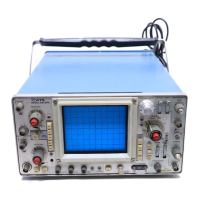TM 11-6625-2735-14-1
Power Input
Power is applied to the primary of transformer T1400
through Line Fuse F1401, POWER switch S1401, Thermal
Cutout S1402, Line Voltage Selector switch S1403, and
the Regulating Range Selector. Line Voltage Selector
switch S1403 connects the split primaries of T1400 in
parallel for 115-volt nominal operation, or in series for 230-
volt nominal operation. Line Fuse F1401 should be
changed for each nominal line voltage (current rating of
fuse for 230-volt operation must be 0.75A fast; for 115-volt
operation current rating of fuse must be 1.5A fast).
Thermal cutout S1402 provides thermal protection for
this instrument. If the internal temperature of the instru-
ment exceeds a safe operating level, S1402 opens to
interrupt the applied power. When the temperature returns
to a safe level, S1402 automatically closes to reapply the
power.
The vacant windings between pins 10, 10A, 11, 12, and
12A or T1400 are intended for use with the optional
Inverter Circuit Board (Option 7) or for use with a 475
Oscilloscope modification, a Power Supply Board (475
DM43 and DM40).
Secondary Circuit
The -8 volt, —15 volt, +5 volt, +15 volt, +50 volt, and
+110 volt supplies are series-regulated supplies. U1418,
U1454A and B, and U1464A and B are high-gain amplifier
cells with differential inputs. These amplifiers monitor
variations in the output voltages and generate error
signals to maintain relatively constant output levels. Each
regulated supply contains a current-limiting circuit that
provides short circuit protection to prevent instrument
damage if a supply is inadvertently shorted to ground.
Additionally, unregulated voltages are used from the +15
volt and + 50 volt supplies.
+50-Volt Supply. The +50-Volt Power Supply provides
the reference voltage for all remaining regulated supplies
in the instrument. The following discussion includes the
description of the +50-Volt Series Regulator, +50-Volt
Feedback Amplifier, +50-Volt Reference, and +50-Volt
Current Limiting stages. Since these stages are closely
related in the production of the +50-volt regulated output
voltage, their operation is most easily understood when
discussed as a unit.
CR1412 functions as a full-wave, center-tapped, bridge
rectifier and provides an unregulated output voltage
(approximately +65 volts) for the +50-Volt Power Supply.
This voltage is filtered by C1414 and is connected to the
+50-Volt Series Regulator, Q1426, to provide a sufficient
collector supply for stable regulation over a wide range of
ac power line voltages. Zener diode VR1416 sets a
reference level of about +9 volts at the positive input of
Feedback Amplifier U1418. A sample of the output voltage
from the +50-Volt Supply is connected to the negative
input of U1418 through divider R1430-R1431-R1432.
R1430 in this divider is adjustable to set the output level of
the +50-Volt Supply. The 2 input voltages at Feedback
Amplifier U1418 are compared and any error between the
2 inputs is amplified. The amplified error output from
U1418 drives Q1424 and Q1426 and controls the output
voltage of the power supply.
Regulation occurs as follows: If the output level of this
supply decreases (due to an increase in load, for example)
the voltage across divider R1430-R1431-R1432 decreases
also. This results in a more negative feedback level at pin 2
of U1418 than that established by the reference voltage at
pin 3. The difference in voltage levels is amplified and
polarity is inverted by U1418. The result is that voltage
increases at pin 1 of U1418. This increase in voltage
causes a more positive voltage at the base of Q1424. More
current is allowed to flow through Q1424 to result in
increased conduction of the +50-volt Series Regulator
Q1426. The output voltage increases, thereby achieving
regulation of the +50-volt power supply.
The +50-volt Current Limiting stage, Q1432, protects
the +50-Volt Series Regulator if excess current is demand-
ed from this supply. Since the load is connected to this
supply through R1426, all current must flow through this
resistor. When excess current is demanded from the +50-
Volt Series Regulator, due to a short circuit or similar
malfunction at the output of this supply, the voltage drop
across R1426 increases, causing a higher positive voltage
at the emitter of Q1426 than the supply output voltage.
This increased voltage is coupled through the emitter-to-
base junction of Q1426 to voltage divider R1424 and
R1425. Under normal conditions, this divider sets the base
level of Q1432 for a biased-off condition. However, when
the power supply load increases beyond preset limits, or
the supply output becomes short circuited, the positive
going change across the divider R1424-R1425 causes
Q1432 to become biased on. The collector current of
Q1432 reduces the voltage at the base of Q1424 to limit the
conduction of current through Q1426 and R1426 to a
preset value. This mode of operation is called foldback
because both the supply voltage and current are reduced
during overload. The supply automatically returns to
normal operation when the overload is removed.
3-23

